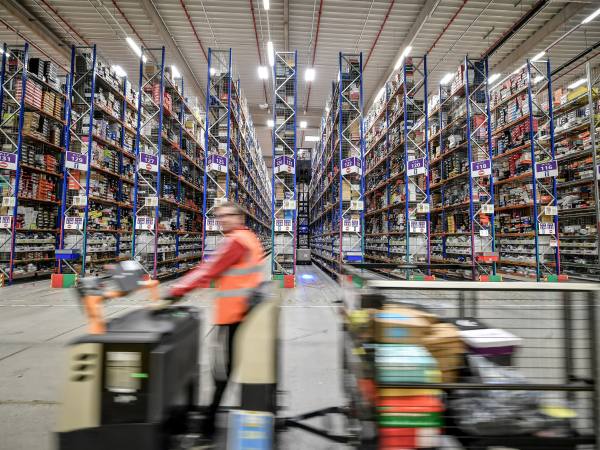- Brad Stone's Everything Store is more than an entertaining history of the evolution of Amazon
- The award-winning book provides important lessons on how Jeff Bezos has created a company that is going to outlive him
When the Everything Store was published in 2013, Amazon’s (US:AMZN) effect on the world was already profound. A place where you could buy almost anything at the touch of a button, and whose impact had long started to be felt on traditional retailers – in informal business jargon, Amazoned: “to watch helplessly as the online upstart from Seattle vacuums up the customers and profits of your traditional brick-and-mortar business”. First books, then music and video, electronics, toys, sporting goods, nappies – little escaped its gaze, and many retailers withered, Circuit City, HMV and many a department store among them.
At the point of its publication Amazon was worth $250bn (£180.2bn) – but it was already clear that this was a different kind of company, as the author puts it, “the most beguiling company that ever existed, and it is just getting started.” The story since has taken its value to $1.7trn, a 10-bagger return even if you had waited 13 years to invest in the company after its IPO and a stark contrast to the old Slaterism “elephants don’t gallop”.
What elephants can do is crush everything in their path, as Amazon has often done. But as Brad Stone’s award-winning account of the coming of the age of Amazon tells us, in the company’s early years, and as the web was still in its relative infancy, it was far from certain that it would ever become the leviathan it is today. “People forget that most people believed Amazon was doomed because it would not scale at a cost structure that would work”, as Eric Schmidt, former CEO and chairman of Google put it.
The account of the early days of Amazon's public life shows the will of Bezos clashing with the bean counters on Wall Street. As losses racked up – including $1bn dollars in 1999 alone – questions were being asked by analysts and the media, even before the dot-com collapse. “Investors are beginning to realise that this storybook stock has problems” wrote Forbes in Spring 1999 in an article entitled “Amazon.bomb.” Ravi Suria, a bond analyst at Lehman Brothers, was especially damning of Amazon’s prospects: “the challenge from Suria and the dot-com collapse had changed the financial climate, and Bezos knew it,” writes Stone.
Suria’s dire predictions that Amazon would run out of cash were proved very wrong – even if his broader fears for the dot-com boom were correct. And Amazon was indeed fumbling through the often irrationally exuberant early days of the internet, haemorrhaging cash and dealing with its own internal struggles to create order around the chaos that came from the genius of its founder. What Suria and others perhaps underestimated was the tenacity of Bezos to overcome them.
Indeed, the almost serendipitous emergence of AWS as Amazon’s core business illustrates that while Bezos was unswerving in his vision, he took opportunities when they came and bent when he needed to, which was often. As the author puts it: “The Amazon we know today, with all of its attributes and idiosyncrasies, is in many ways a product of the obstacles Bezos and Amazon navigated during the dot-com crash, a response to the widespread lack of faith in the company and its leadership.”
It is certainly impossible to disentangle Amazon from its founder, and his determination to achieve the impossible. As the author puts it, he is a modern Henry Ford, transforming retail in the way that Ford transformed transportation. Although for Bezos the impossible was building another Walmart; 113 mentions in the book, the source of many a poached Amazon employee, and whose core values “frugality and a bias for action—a willingness to try a lot of things and make many mistakes” are included within Amazon’s own.
For Bezos, the next impossibility to defeat is space. Like many kids he dreamed of reaching the stars, but unlike most of them his wealth means he might be able to do it. “The reason he’s earning so much money is to get to outer space” said his high school girlfriend when interviewed in the mid 1990s. By 2005 he had already acquired 290,000 acres of ranch land as a base for his secretive Blue Origin rocket company; by 2011 test flights has begun. In 2021, Bezos launched himself out of the Amazon hot seat to focus on his other ventures including Blue Origin. He will be replaced later this year by Andy Jassy, the head of its cloud computing business.
It is a telling appointment, and an indication that Amazon now sees itself more as a technology company than a technology-enabled retailer. Bezos’s departure is also a sign that an organisation built largely on the sheer willpower of its founder has transformed into one that can now exist without him, and in fact needs to exist without him as power in the technology industry shifts from visionary, and often turbulent, founders to employees. As is the case across much of Silicon Valley, employees are pursuing unionisation, an environment perhaps not best suited to Bezos’s demanding management style which left many casualties in his wake, but which has changed the world as we know it. Amazon’s next chapter may offer less of rollicking story than the first, but Bezos’s may yet change the world again.








